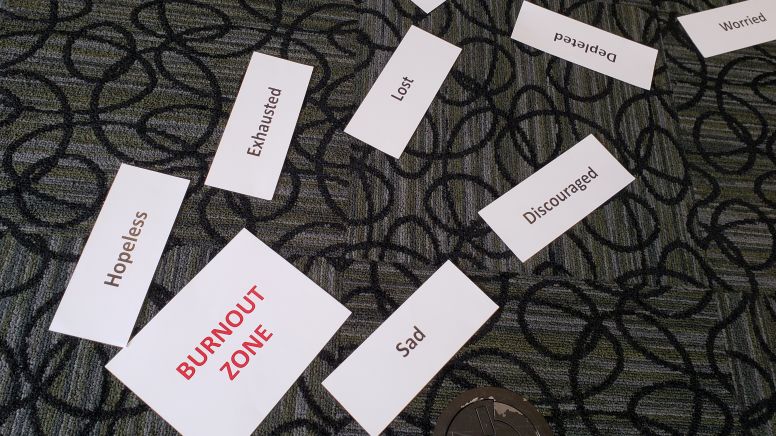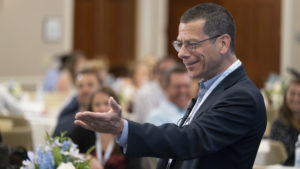News & Stories
Avoid burnout by building resilience

Burnout. It is so common that the World Health Organization (WHO) identified it as an “occupational phenomenon” in May 2019.
Although not classified as an actual medical condition, WHO defines burnout as “a syndrome conceptualized as resulting from chronic workplace stress that has not been successfully managed.”

Rob Goldberg shares strategies to avoid workplace burnout at our MBA@UNC Alumni Immersion.
What’s the key to avoiding burnout? Build your own personal resilience, says Robert Goldberg, an affiliate faculty member at UNC Kenan-Flagler, by deepening your understanding of burnout and its characteristics.
Three dimensions characterize burnout, according to WHO:
- Feelings of energy depletion or exhaustion
- Increased mental distance from your job or feelings of negativism or cynicism related to your job
- Reduced professional efficacy
During our 2019 MBA@UNC Alumni Immersion , Goldberg led “Building Resilience, Avoiding Burnout.” In an interactive exercise, alumni explored dynamic “energy zones” that people need to be aware of and manage to avoid burnout. Adapted from “The Power of Full Engagement” (Loehr & Schwartz, 2003), the zones and their characteristics are:
- Performance zone: Passionate, enthusiastic, engaged, optimistic, alive, challenged and absorbed
- Survival zone: Anxious, impatient, angry, irritable, defensive, fearful and frustrated
- Burnout zone: Hopeless, exhausted, sad, discouraged, lost, empty, worried and depleted
- Recovery zone: Calm, peaceful, grateful, relaxed, receptive, relieved, rested and renewed
The key to staying in the performance zone is to move into the recovery zone before you enter the burnout zone. Goldberg says you can recover every day, even a little bit, by managing four types of energy:
- Physical: Take a break or a short walk every 90 minutes, to avoid burnout.
- Mental: Focus on the most important tasks and define how they get done.
- Emotional: Feel valued and appreciated for your contributions.
- Spiritual: Do work that connects to a higher purpose or mission.
Building personal resilience is another way to maintain peak performance. Goldberg defines resilience as the ability to become strong, healthy and successful after something bad happens.
Goldberg shared the five factors for resilience capability:
- Perspective – Step back and accept the negative aspects of a situation while finding opportunity meaning. Recognize what can be changed and what can’t
- Emotional intelligence – Become aware of your emotions and name them. Give yourself permission to have those feelings without guilt or shame, and allow space and time to process your feelings. It’s about managing your emotions and impulsivity.
- Purpose, values, strengths – Have a clear sense of the purpose about your work and a clear sense of your values and moral compass to stay centered when there is disruption.
- Connections – Connect with your network of friends and colleagues for support. Gain strength by supporting others
- Managing physical energy – Keep physically fit, eat well and don’t use food as a crutch. Find time away from work to engage in activities that you enjoy
A majority of the alumni use physical energy to build resilience but said they would like to build their capabilities across all five factors.
To wrap up the session, Goldberg shared the Roffey Park Survey to determine individual resilience capability indexes. It determines if someone is better at adapting to stressful situations than others, recovers quickly from adverse experiences and reacts positively to change.